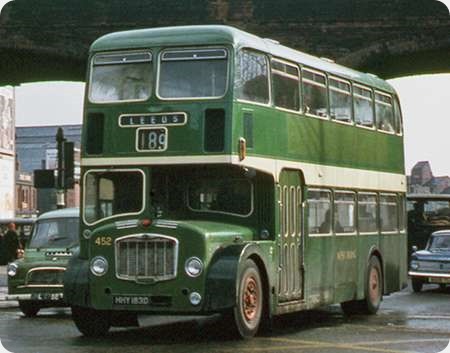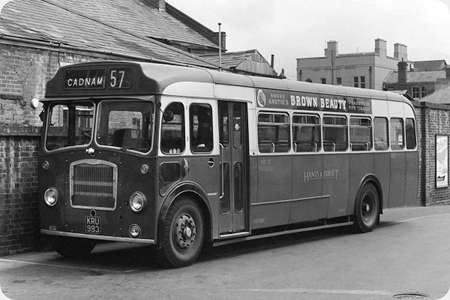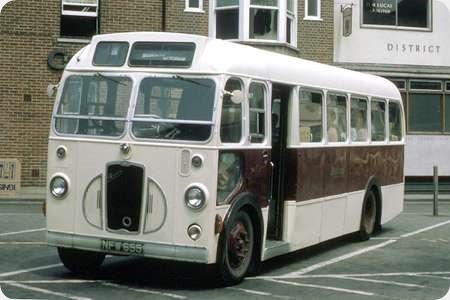
West Riding Automobile
1966
Bristol Lodekka FLF6G
ECW H38/32F
Proceeding on a very wet day into Leeds city centre is West Riding No. 452, Bristol FLF6G HHY 183D with ECW H38/32F bodywork, originally delivered to Bristol Omnibus as C7280 in October 1966. When, in 1967, West Riding sold out to the Transport Holding Company, which became the National Bus Company in 1969, steps were taken to withdraw the very troublesome Guy Wulfrunian fleet, and to secure this end as quickly as possible, buses were transferred from various parts of the NBC empire. This FLF6G was sent from Bristol Omnibus to West Riding in February 1970, so it had not been there very long when I took this picture in April of that year. In November 1971 it was renumbered 544 and stayed with West Riding until 1980, during which period it acquired the abysmal NBC poppy red livery. It was then sold to Top Deck Travel of Horsell Common with whom it spent several years in the USA up to 1986 before finally being consigned to the scrapyard in 1989.
I acknowledge this very informative website as the source of much of the foregoing information:– //bcv.robsly.com/lodekka.html
A complete West Riding fleet list may be found at this link
Photograph and Copy contributed by Roger Cox
01/10/20 – 06:33
If it’s not my imagination, this bus appears to have hub caps on the rear wheels. If this is the case, was this a West Riding feature carried forward to this hotchpotch of foreign incomers!
Chris Hebbron
02/10/20 – 06:41
This is a good point, Chris. I have blown up the picture on my computer screen, and you are right. I hadn’t noticed the rear wheel trims, rather similar to those on London Transport RT/RTL/RM/RF types. I have looked at my own pictures of other West Riding buses – Guy Arabs and Wulfrunians, Daimler Fleetlines, AEC Reliances, and other’ imports’ brought in to ease the Wulfrunian crisis, and none have these wheel trims. Perhaps an OBP expert can enlighten us.
Roger Cox
02/10/20 – 06:42
The black fibreglass rear wheel trims were introduced as standard NBC spec. mid 1960s to all Bristol chassis. Somebody must have thought it looked smart and perhaps would aid mechanical vehicle washing without asking the operating engineers. The need to remove the covers for every tyre pressure check and wheel nut tightening led to depots under pressure (pun not intended!) leaving them off and then taking off the fixing brackets which incorporated a spring loaded catch and became a bit of a danger as they stuck out, being bolted to the axle shaft hub. Few Chief Engineers insisted on re-instatement because the newer vehicles then looked the same as the earlier deliveries and weren’t noticed! No doubt there were enthusiast depot engineers (usually at smaller and remote locations) around the country who took pride in retaining the wheel covers in good condition.
Geoff Pullin
02/10/20 – 06:44
I wonder (suppose, really) that I’m the only person who thinks the ECW Lodekkas are amongst the best looking double deckers ever to enter service.
Angular, functional, almost minimalist design which was of its age, no doubt, but which still looks perfect for the job it was designed to do.
Or is it my age and I haven’t moved on – old buses are as much a part of me in the same way I still look at TV actresses from that era and think that Jan Francis, Paula Wilcox, Felicity Kendall etc, etc haven’t really been improved upon 50 years later??
Stuart C
03/10/20 – 06:33
No Stuart C, you’re not the only one who considers the Lodekka to have been among the best looking double deckers. I must admit to a slight preference for the rear entrance variety, with their more raked fronts. Having been a conductor for a brief period, I also appreciated the extra space on the platform – on an FLF, I always seemed to be in the way!
Nigel Frampton
03/10/20 – 06:34
It’s nice that these vehicles arrived in time to wear the traditional West Riding livery and fleetname, if only for a couple of years. As Roger says, the adoption of NBC poppy red was regrettable and something of a mystery when every other NBC fleet for miles around was also red, the nearest fleet to opt for green was perhaps East Midland, a considerable distance away.
It’s also good to see that WR went to the trouble of having non-standard destination blinds made to fit the aperture which was nothing like their own standard display. Dare I say, some may have been content to simply show the word ‘Service’.
Chris Barker
03/10/20 – 10:26
This photo also illustrates how the cream glazing strip that ECW used for a few years made the destination aperture look smaller. In this case it looks as if the already small lettering is too big, yet with black glazing strip it would look fine!
If I remember rightly, the cream rubber coincided with complaints that the older green leathercloth interior side panels and green criss-cross Formica on seat backs looked a bit dull. It always looked to me that the response was that of an engineer looking through the pattern books (and certainly not an interior designer) – and choosing golden leaves cream Formica instead.
The radiator cap also looks to be painted red. That was most probably part of the necessary operation in those days of using antifreeze only during the winter and the cap would have been painted red (or a different colour each year) for drivers to know that it needed topping up with antifreeze mix and not water. Happy days!
Did anyone else feel vulnerable sitting at the back downstairs of an FLF? I always avoided those seats!
Geoff Pullin
08/10/20 – 06:50
Chris. This isn’t the "traditional" West Riding livery – it is Tilling green which West Riding adopted after it sold out to the THC, the traditional West Riding green was a shade lighter/brighter. I understand that the decision of West Riding to adopt NBC poppy red was driven by the Regional Director who wanted an "all red" Region; I suspect that the West Riding Group GM, Fred Dark, who had come from Yorkshire, didn’t put up too much resistance given that if West Riding had adopted leaf green then Yorkshire would probably have had to do the same under NBC’s rationalist policies.
Philip Rushworth
09/10/20 – 16:13
Presumably this bus, being quite new on its transfer to West Riding, simply retained its Bristol Omnibus Tilling Green.
Roger Cox
10/10/20 – 06:56
As I understand it, West Riding adopted NBC red because the regional management wanted an "all-red" area as Philip says, but that wasn’t universal across all areas of NBC. In the south, Western National used green, but Devon General (which was by then under common management with WN) used red. A similar situation applied to Provincial (green) which was managed by Hants & Dorset (red); and Cheltenham (red) was a subsidiary of Bristol OC (green).
Nigel Frampton
21/10/20 – 06:46
West Riding were a partially red fleet for many years as the former tram routes were run with red vehicles West Riding had actually begun to change from their traditional green to Tilling green before the Lodekkas began to arrive.
On the subject of the use of NBC red there is an apocryphal story that Yorkshire Woollen and West Riding tossed a coin and West Riding lost!
Chris Hough
14/11/20 – 07:38
I am coming to this a bit late, but I have been very interested to read all the comments in the string above. I have not worked on buses, as Nigel Frampton has, but purely from a user point of view, I loved the Bristol Lodekkas. When I was a boy in York I would try to get my mother to take us home from Exhibition Square, where the routes 2, 8 and 12 home were all Lodekkas, rather than from Stonebow (mostly VRs – which I also am now very fond of).
I read a very good book about the Routemaster, in which the author referred to the Lodekka as a Behemoth. I think that was unfair! When I moved down to London in 1989 I enjoyed being able to step back in time to use the Routemasters, but they did seem very narrow and rickety compared with the Lodekkas.
Henry Arthurs



